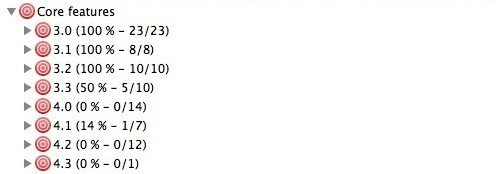During Apple’s WWDC 2013 keynote, the graphically-inclined may have noted “OpenGL 4” among OS X Mavericks’ feature list. I was curious and decided to study OpenGL support between Mountain Lion and the developer preview of Mavericks. The comparison was done on my non-production workstation using OS X Mountain Lion (10.8.4) and OS X Mavericks (10.9 DP1). I utilized OpenGL Extensions Viewer 4.0.8 (App Store version) for the following assessment.
First, I looked at the OpenGL core feature support (Core OpenGL profile, SGI database).
One can see that while Mountain Lion didn’t even completely support OpenGL 3.3, Mavericks has support through OpenGL 4.1. 🙂
Next, I did a compatibility test for OpenGL 1.1 – 2.1 using the default settings (cube, default frame buffer, etc.) The results speak for themselves.
While I completely understand that this is a crude assessment and the aforementioned results could easily change (for better or worse) in subsequent OSX 10.9 builds, it’s nice to see more modern graphics libraries being incorporated into OS X.










Are the values the same with DP2 of Mavericks?
Hi, what GPU did you test?
Geforce 660Ti
Interesting. On the geforce 9400M and 9600M GT, Mavericks is quite a bit slower at all GLview tests.
and to continue on this, I get better results than yours on my Mac Pro (2.66 xeon 5150, radeon 4870), which should be much slower than your hackintosh: 640 fps on average in the default windowed mode, 3700 fps on average in fullscreen mode (1680*1050). BTW, the huge performance increase in fullscreen despite the higher resolution makes me wonder about the usefulness of this tool as a benchmark.
The GLView cube test really doesn’t mean much as the Unigine Heaven benchmark gives totally different results (where 10.9 is actually faster than 10.8 on my system). You should try that benchmark. It is much closer to a real-world situation than a rotating cube.
I really want to see testing done in native mac games vs Windows 8. I saw some tests long ago on Anandtech with I think Snow Leopard, and it made GPUs perform like they were a generation older than they are compared to Windows, I wonder if that’s fixed.
Also, despite the huge numbers in absolute FPS remember that this, scaled, is like going from 60 to 62FPS.
Imagine my surprise as I casually follow a front-page HN link and realize halfway through the post that it’s my old friend Rishi’s blog… haha! Glad to see your interest in tech is still strong even during the hard work of residency. And thanks for the relevant post, too, as I just switched to Mac last week after 20+ years solely on Windows (2013 MBA). Hope you’ve been well, man!
Cool comparison – fire up a game and do a comparison?
or use something like https://unigine.com/products/benchmarks
Well, this is not about performance, just compatibility.
Without compatibility, there is no way one could start performance testing on those areas.
Of course, if you want to test speed, we might get a hint right now by running it, but since this is not release, certain things might be better or worse during the final release then.
I’d prefer to just wait on that one.
Absolutely – this was intended purely to show compatibility as performance will vary based on GPU, build number, etc.
Cool. Still wonder why they didn’t go all the way to 4.3.